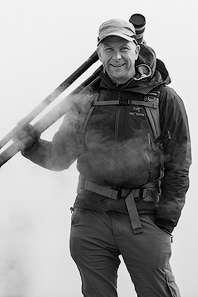This week on the blog I am sharing a complete chapter from the new edition of my Developing for Extended Dynamic Range tutorial series. In this chapter I demonstrate how luminosity masks and a technique called masking-the-mask are useful in creating better tonal balance in high dynamic range exposures. Dynamic range is one of the many challenges we face as outdoor, natural light photographers. Dynamic range is the visual contrast (difference between the darkest and lightest values) in a scene or an image. A common way to handle extreme dynamic range light, in the 12 to 25 stop range, is by bracketing exposure values and blending the exposures in Photoshop to create a properly exposed final image. While I find multiple exposure blending to be an essential technique, with advancing camera technology it isn’t needed as often as it once was. Some current digital cameras have the ability to record a dynamic range of 11 to 14 stops, unimaginable just a few years ago. A dynamic range of 13 stops equates to a contrast ratio of over 8,000:1 and 14 stops, a contrast ratio of over 16,000:1. Such contrast range means it is possible to capture many high dynamic range scenes, which were previously out of reach, in a single exposure. Unfortunately, the dynamic range of the best monitors is only in the 1000:1 range. Prints can only achieve a dynamic range between about 50:1 up to perhaps 300:1, depending on paper, printing process and lighting. So even if our cameras can record a wide dynamic range in a single exposure, we still need to work with shifting the the bright and dark tones in the image to create tonal balance and retain tonal detail, while still giving the perception of the actual dynamic range that we saw.

There are many tools and techniques available for shifting tonal values in an image for better tonal balance, including raw highlight and shadow recovery, dodging and burning and the Shadows/Highlights adjustment in Photoshop. A common tool I use is Curves or Levels adjustments guided by the use of luminosity masks. In the video chapter below I demonstrate the great control, precision and flexibility that luminosity masks provide when working with targeted tonal balance in a single exposure image. It also provides some great extended instruction in the use of the TKActions Panel. I hope you find the information helpful in your image developing. Make sure to view the video in 720p HD!
This chapter is one of 36 in the updated edition of the Developing for Extended Dynamic Range tutorial series. The series takes a complete look at working with high dynamic range light from capture to single and multiple exposure developing methods. You can go here if you would like more information or to see more chapters. I’d be glad to field any comments or question you have in the comments section below.

Sean is an outdoor photographer, digital image developing enthusiast and photography educator based in Ashland, Oregon, where he resides with his wife and two sons. His previous career as a science teacher makes photography education a good fit. Sean teams up with fellow Photo Cascadia members leading workshops. He also teaches digital image developing classes, lectures and offers a series of Photoshop video tutorials.
More posts by Sean Visit Sean’s Image Gallery Visit Sean’s Website

Recent Comments